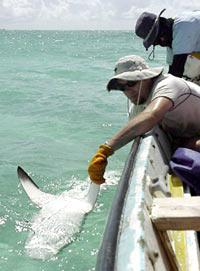Spending his days fishing on the beaches of Martha’s Vineyard — an island off the south coast of Cape Cod — a then-8-year-old Chris Lowe discovered his affinity for marine life. There was not much else for a kid to do on the island but fish and go diving in the summer.
“I was in the water all the time,” Lowe said.
Some said the connection to marine animals was in his blood; his mother’s family has been on the island for more than 250 years, so there was a long line of whalers and commercial fishermen in the family tree.
But for Lowe, it was sharks — a species that gets a bad name in the fishing world — that caught his eye.
“Out of all the different fish I would catch, there was something about sharks that I thought was so cool,” Lowe said.
He said he then decided to become a marine biologist, which was not always a popular profession in a community of commercial fishermen.
“Many commercial fishermen blame the biologists for the decline in the fishing industry because of fishing regulations,” he said. “So I was on the dark side.”
Lowe, who has been a professor at Cal State Long Beach for the past 12 years, has brought his expertise on camera appearing in about 20 television productions for stations like Discovery Channel and Animal Planet. His most recent appearance was in January, on the inaugural episode of Animal Planet’s “I, Predator,” a series that explores the interactions between predator and prey.
Lowe was involved early on in production, spending hours educating the crew. “It was like having a group of college students,” he said.
He had to explain the physiology of the shark and the sensory biology of the shark so the production crew could understand how the white shark could recognize a seal from something else.
“My job is to be a scientist and educate people,” Lowe said. “The main reason why I do these productions is to get accurate information out to the public about what we really know about sharks, and sometimes that means saying we don’t know.”
Sharks are the most popularized marine animal, Lowe said, but often they are depicted as mindless eating machines – typified in Steven Spielberg’s 1975 blockbuster hit “Jaws” (which coincidently was partly filmed on location at Martha’s Vineyard).
Sharks have even garnered their own week-long special on television that has become popular with viewers, but Lowe warned that only about 40 percent of the information you hear is true.
“I call Shark Week junk food for your mind,” Lowe said. It is this type of programming that feeds this idealized and hyperbolized perception of sharks and their behavior.
“There is a group of people that like to be scared; that is what is entertaining,” Lowe said. “But what we have to be careful of is blurring the line between what is educational and what serves a purpose and what is for entertainment.” The popularity of sharks in the media does not directly translate into scientific knowledge.
“The thing that never ceases to amaze me is with all the programming and all the literature we have about sharks, people seem to think we know a lot about sharks when, in reality, we don’t,” Lowe said.
Shark research is an ongoing and ever changing project. Sharks are hard to study because of the wide range in species and the depletion in population due to over fishing and loss of habitat. “Most sharks are a lot like humans; they grow very slowly, some species don’t reach sexual maturity until they are 25 years old, and they produce very few young the rest of their lives. So it is easy to deplete their population,” Lowe said.
Lowe is the director of CSULB’s Shark Lab, which was established in 1969 by Don Nelson, a pioneer in the development of shark tracking devices.
Lowe and his students have worked closely with the restoration of the Bolsa Chica Wetlands, and are monitoring how quickly shark and ray populations are growing. Since the opening of the full tidal basin to the ocean in 2006, the ray and shark population has increased greatly, indicating how well these types of restored habitats come back.
“If we have evidence that these rays are using restored areas, that tells resource managers that if you do these restoration projects, you will see communities form only after two years,” Lowe said.
Lowe’s shark research has taken him to remote islands that have minimal human impact, including Palmyra and Bikini Atoll.
These islands provide a unique experience for Lowe as he is able to observe sharks that have been unaffected by human interaction. In these waters, sharks are less shy and often circle Lowe as he dives, which is more exciting than terrifying, until they become bored and swim away.
“They are not afraid,” Lowe said. “It is hard to convey to people how small you are when you are in the ocean.”
Unfortunately, Lowe said, as humans continue to build on lands that were once wild, these types of intimate and uninhibited encounters will happen less frequently.
Disclaimer: The Daily 49er is not responsible for Postings made on www.daily49er.wpengine.com. Persons commenting are solely responsible for Postings made on this website. Persons commenting agree to the Terms of Use of the website. If Postings do not abide by the Rules of Conduct or Posting Regulations as listed in the Postings Policy, the Daily 49er has all rights to delete Postings as it deems necessary. The Daily 49er strongly advises individuals to not abuse their First Amendment rights, and to avoid language suggestive of hate speech. This site also encourages users to make Postings relevant to the article or other Postings.




